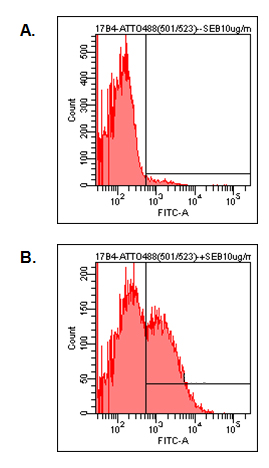anti-LAG-3 (human) mAb (17B4) (ATTO 488)
| Code | Size | Price |
|---|
| AG-20B-0012TD-T100 | 100 tests | £360.00 |
Quantity:
Prices exclude any Taxes / VAT
Overview
Host Type: Mouse
Antibody Isotype: IgG1
Antibody Clonality: Monoclonal
Antibody Clone: 17B4
Regulatory Status: RUO
Target Species: Human
Applications:
- Flow Cytometry
- Immunocytochemistry (ICC)
Shipping:
+4°C
Storage:
4°C
Images
Documents
Further Information
Alternate Names/Synonyms:
Lymphocyte Activation Gene-3; FDC Protein; CD223
Concentration:
1mg/ml
EClass:
32160000
Form (Short):
liquid
Formulation:
Liquid. In PBS containing 0.02% sodium azide.
Handling Advice:
Do not freeze.Protect from light.
Immunogen:
Synthetic peptide corresponding to 30 aa in the N-terminus of human LAG-3.
Labels - Conjugates:
ATTO 488
Long Description:
Monoclonal Antibody. Recognizes human LAG-3. Isotype: Mouse IgG1. Clone: 17B4. Applications: FACS, ICC. Liquid. In PBS containing 0.02% sodium azide. Lymphocyte activation gene 3 (LAG-3; CD223) plays an important role in negatively regulating T cell proliferation, function and homeostasis. It is required for maximal natural and induced regulatory T cell (Treg) function. LAG-3 is closely related to the T cell co-receptor CD4 and binds to MHC class II molecules but with a significantly higher affinity than CD4.
NCBI, Uniprot Number:
P18627
Other data:
New ATTO-fluorescent antibodies show increased photostability, outstanding brightness and intense signals. ATTO dyes are thermally stable, resistant to environmental changes and show no significant isomerization. ATTO 488 shows bright green fluorescence (lambdaabs (max): 501nm, lambdaem (max): 523nm, epsilonmax: 90?000).
Package Type:
Plastic Vial
Product Description:
Lymphocyte activation gene 3 (LAG-3; CD223) plays an important role in negatively regulating T cell proliferation, function and homeostasis. It is required for maximal natural and induced regulatory T cell (Treg) function. LAG-3 is closely related to the T cell co-receptor CD4 and binds to MHC class II molecules but with a significantly higher affinity than CD4.
Purity:
>95% (SDS-PAGE)
Source / Host:
Purified from concentrated hybridoma tissue culture supernatant.
Specificity:
Recognizes human LAG-3.
Transportation:
Non-hazardous
UNSPSC Category:
Primary Antibody Conjugates
UNSPSC Number:
12352203
Use & Stability:
Keep conjugated formats at +4°C. Stable for at least 1 year after receipt when stored at +4°C.
References
Characterization of the lymphocyte activation gene 3-encoded protein. A new ligand for human leukocyte antigen class II antigens: E. Baixeras, et al.; J. Exp. Med.176, 327 (1992) | Cellular expression and tissue distribution of the human LAG-3-encoded protein, an MHC class II ligand: B. Huard, et al.; Immunogenetics 39, 213 (1994) | Characterization of the major histocompatibility complex class II binding site on LAG-3 protein: B. Huard, et al.; PNAS 94, 5744 (1997) | CD3/TCR complex-associated lymphocyte activation gene-3 molecules inhibit CD3/TCR signaling: S. Hannier, et al.; J. Immunol. 161, 4058 (1998) | T Lymphocytes infiltrating various tumour types express the MHC class II ligand lymphocyte activation gene-3 (LAG-3): role of LAG-3/MHC class II interactions in cell-cell contacts: C.E. Demeure, et al.; Eur. J. Cancer 37, 1709 (2001) | Immunological mechanisms elicited at the tumour site by lymphocyte activation gene-3 (LAG-3) versus IL-12: sharing a common Th1 anti-tumour immune pathway: E.D. Carlo, et al.; J. Pathol. 205, 82 (2005) | The negative regulatory function of the lymphocyte-activation gene-3 co-receptor (CD223) on human T cells: L. Macon-Lemaitre and F. Triebel; Immunology 115,170 (2005) | A soluble lymphocyte activation gene-3 (sLAG-3) protein as a prognostic factor in human breast cancer expressing estrogen or progesterone receptors: F. Triebel, et al.; Cancer Lett. 235, 147 (2006) | Human dendritic cells acquire a semimature phenotype and lymph node homing potential through interaction with CD4+CD25+ regulatory T cells: J. Bayry, et al.; J. Immunol. 178, 4184 (2007) | Human lymphocyte activation gene-3 molecules expressed by activated T cells deliver costimulation signal for dendritic cell activation: C. Casati, et al.; J. Immunol. 180, 3782 (2008)



